blueorchid
you soft and only
- Joined
- Apr 4, 2009
- Messages
- 7,806
- Reaction score
- 5,077
The Red Carpet Highlights of... The 77th Annual Cannes Film Festival 2024!
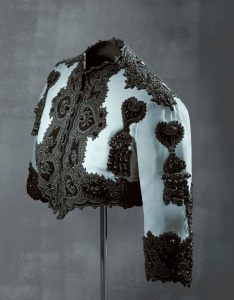
Short jacket with square collar. The panels come to a peak at the front. Three-quarter-length sleeves. Adorned with piping and glass-paste beading, creating floral and heart-shaped motifs. The front and sleeves are decorated with tassels.
Made in Spain. Balenciaga was inspired by the short bullfighter jackets, characterised by their style and by the intricate decoration in braids and beads, inherited from the 18th-century clothing of the majos. This jacket, also called a shrug or bolero, is a beautiful example of those presented by the couturier in his 1947 winter collection.
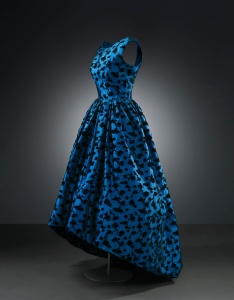
Round neck at the front and crossover V-neck at the back. The bodice is fitted and cut at waistline. The full skirt is gathered at the waist. It is shorter at the front than the back. The lining is straight to knee length, where it opens in three layers to give volume to the skirt.
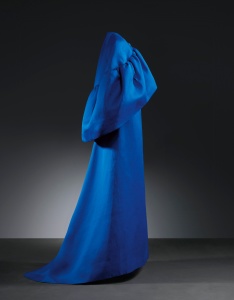
Long dress with a short train at the back. Higher neckline at the front and low cut at the back. Sleeveless, cut at waistline. The bodice is fitted with darts and fastens at the centre of the back with hooks and press-studs. The évasée skirt is gathered at the waist. At the back, the waist is dropped to the hipline in the shape of a “U”. Lined with silk organza in the same colour. The mantelet has a square collar and yoke with wide gathered frill, which slopes downward toward the back. The fitted blue silk petticoat fastens at the left with a zip.
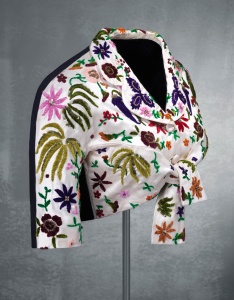
A jacket to accompany a party dress. The front is ivory satin and the back is black crepe. Reinforced with shoulder pads. Short, below the bustline, with V-neck and collar with lapels. Fastens at the front with two buttons and a tied with the pieces that extend from the sides. The front is embroidered with chenille thread, acetate sequins, beads and twisted golden thread to form floral motifs of Oriental influence.
Made in Paris for the February 1946 collection, model number 113. It is a magnificent piece embroidered by Lesage, a close collaborator of the Balenciaga house. Also known as “La Perse”, it is identical to the model held in the Nederlans Kostuummuseum in The Hague, property of the Dutch concert pianist Else Rijkens. It was worn with a black dress and a matching hat in embroidered satin.
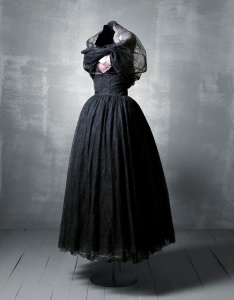
Long dress cut at waistline, reinforced on the chest with metallic boning sewn into the lining. The pale-pink satin bodice is fitted with vertical darts and has a sweetheart neckline with strap. The full skirt is gathered at the waist. The dress fastens on the left side with a metallic zip. Complemented with a stole that covers the shoulders.
This glamorous dress, made in the EISA workshop in Madrid, reflects the phase in which Balenciaga contrasted different coloured fabrics. The references to Spanish clothing are present in this piece, seen not only in the layers of lace, highlighted against a shiny satin base, but also in the stole that covers the shoulders and is decorated with fans and castanets.
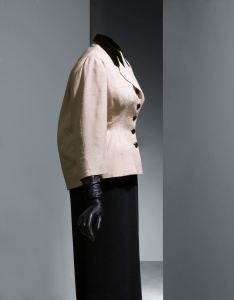
Hip-length jacket, open at the front, with a black velvet turndown collar and lapels. The front is fitted to the waist with darts. The straight, loose back adapts to the shoulder line with two darts. The three-quarter sleeves are assembled with three panels. Lined with ivory silk taffeta. An inside strap hugs the garment to the body, leaving the outside free and accentuating the fullness of the back.
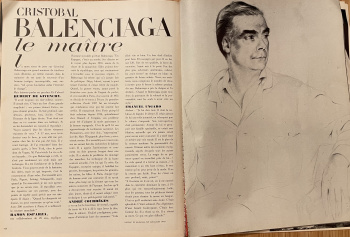
La mort vient de jeter sur Cristobal Balenciaga sor grand manteau de ténèbres mais illumine, au même instant, dans la mémoire le ses amis le souvenir d'un homme intègre, incorruptible, vrai, sincère, "tel qu'en lui même enfin l'éternité le change".
Mois laissons parler ses proches. Et d'abord HUBERT DE GIVENCHY. "Il avait toujours un merveilleux sourire. Il aimait rire. C'était un être d'une grande simplicité ; ses peines étaient fortes, ses joies étalent grandes. Il était profond, sans détours, généreux, bon, lucide. C'était l'homme de la ligne droite. Tout était net dans sa vie comme dans ses tailleurs. Si on lui demandait un conseil, il répondait : "Soyez naturel. Que les choses viennent vraiment de vous." A 17 ans, avec trois dessins sous le bras, je suis allé me présenter chez lui. Je n'ai pas été reçu. Il y avait barrage. Je l'ai rencontré bien des années après, à New York, chez le président de Vogue, M. Patcévitch.La vie a de ces hasards... Ce que Balenciaga a créé, ce n'est pas seulement un style mais une technique. Il a été l'architecte de la Haute Couture. Vous pouvez avoir de la fantaisie, des idées, mais ce qui importe, c'est la construction d'une robe. J'ai travaillé avec Fath, Piguet, Lelong, Schiaparelli, mais quand je l'ai rencontré, je me s uis aperçu que je ne savais rien. Il travaillait avec des, équerres sur ses pauons, avec des points de repère aussi précis que sur une épure. Il disait : "Quand la charpente est bonne, on peut construire ce qu'on veut." Avec 500 ouvrières à Paris, il a influencé la couture mondiale."
RAMON ESPARZA, son collaborateur de 25 ons, explique l'homme invisible qu'était Balenciaga. "En Espagne, c'était un mythe. Ses clientes ne le voyait plus depuis 1931, année de la chute de la monarchie. Elles avaient boycotté la république, ceux qui continuaient à travailler sous le nouveau régime, et Balencinga lui-même qui n'a jamais fait de politique. Déçu, blessé, voyant à quoi tenait l'amitie il s'était retiré du monde. Quand, la guerre venue, ayant passé la frontière avec juste de l'argent de poche, il s'est installe à Paris, il se souvint de 1931 et décida de se tenir à l'écart. Sa première collection d'aoùt 1937 fut un triomphe qui remboursa ceux qui lui avaient fait crédit. Il connaisait bien Paris puisqu'il était acheteur depuis 1914, spécialement chez Chanel. A l'origine, son problème avait été d'adapter la mode parisienne à la femme espagnole. C'est là qu'il lit son apprentissage de technicien novateur. Les Parisiennes, avec leur chic, "emportaient" la robe. Mais l'Espagnole, plus forte, y réussissait moins. Il a travaillé jour et nuit comme un savant fait des recherches de laboratoire. Il a appris l'architecture et comment on doit pouvoir bouger dans une robe. Il a résolu le problème du montage es manches. La technique de la haute couture actuelle, e'est lui qui l'a créée. En Espagne, couturier unique, il habillait les grosses, les maigres, les petites, les grandes, les mères, les filles. A Paris, chaque type de femme ava it son couturier. Il en savait donc plus long sur la femme que tous les autres couturiers de l'époque. Les lois qu'il a découvertes sont exactes. Il aurait été plus jeune, disait-il, il aurait adopté cette technique à un prêt-a-porter industriel."
ANDRÉ COURRÈGES a vu en lui le bourreau de travail, capable de tenir de 9 h à 22 h sans lever la tête, dans le silence. Vitalité prodigieuse, puissance d'attention hors du commun. "Cela allait vite et bien. Un bon chef d'atelier peut faire 30 essayages par jour. Il en faisait 120. Une de ses qualités, la force de charatère. Ayant mis à la porte l'un des plus gros acheteurs américains, celui-ci lui avait envoyé un chèque en blanc en garantie de futurs achats. Nous, ses assistants, nous comptions le nombre de zéros à mettre pour le forcer à acheter pendant dix ans. Balenciaga a pris le chèque et l'a déchiré... Chanel et Balenciaga, ayant tous deux la puissance de la volonté let la personnalité, sont les seuls à avoir créé un style.
EMANUEL UNGARO déclare : "Je lui dois tout. Il é1ait la noblesse, le dignité, le silence. li créait autour de lui une telle intensité. un tel respect que le silence s'imposait. Son introspection était permanente. Autour de lui se groupait une famille spirituelle, se créait une filiation naturelle qui n'a jamais existé pour aucun autre couturier. Il a tracé dons ce métier une voie royale. Il est le père de la couture moderne. Sa personnalité dominait. Il faisait naître des moments exceptionnels auprès desquels tous les autres paraissaient creux. La magie de sa présence quand on travaillait près de lui ... ! Le vide quand il a fermé sa maison ... ! Il maintenait à un très haut niveau, le sentiment qu'on peut avoir de la mode. Il ne la croyait pas futile. Pour lui c'étoit un acte profond, senti, pensé."
"A Gueturia où il est né, où il esl enterré dons le cimetière dominant lo mer, à l'église qui est extraordinairement belle, tous les paysans, tous les pêcheurs étaient réunis pour chonter ln messe en basque. C'est ce qu'il souhaitait sans doute. C'était splendide. C'était solennel. Pas déprimnant. D'une beauté foudroyante. C'était fort. Comme lui. Ii a réussi sa vie. Il a réussi sa mort. Ce qui est plus difficile."

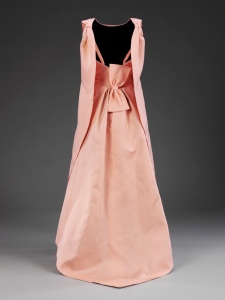
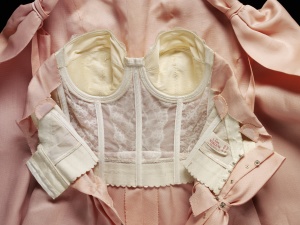
Pink gazar silk evening dress with lace bustier. There is a built-in brassiere which forms the bodice section at the front. The dress itself is bagged out with a second layer and is cut from one rectangular piece of silk gazar. The gazar is mounted under the front skirt sections. The bow at the back is double folded with pleated tabs. The shoulders also have pleated tabs.
Details
- Title: Evening dress Evening dress
- Creator: Cristóbal Balenciaga
- Fashion House: Cristóbal Balenciaga
- Date Created: 1965
- Location Created: Spain
- Physical Dimensions: Length: 139.3 cm Centre front, Length: 2 cm Centre front seam, Circumference: 48.4 cm Neck line, Circumference: 47.6 cm Armscye, Circumference: 36 in Bustline, Circumference: 68 cm Skirt waist, Length: 69 cm Skirt centre front, Length: 133.56 cm Skirt centre back, Length: 6 cm Skirt hem, Length: 15.27 cm Bodice centre back, Length: 24.96 cm Bodice side back, Length: 24.29 cm Front neck drop
- Provenance: Given by Miss Ava Gardner
- Medium: Gazar silk with lace
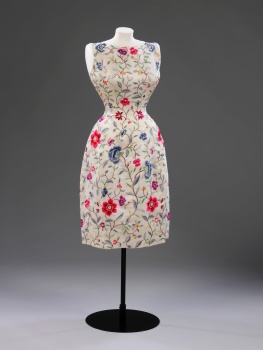
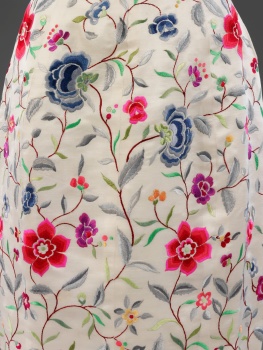
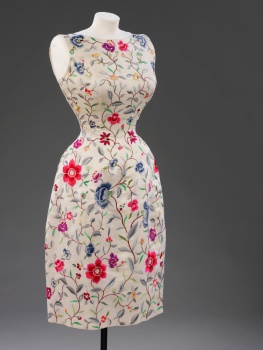
Short evening dress of white wild silk, with hand embroidered coloured floral motifs in the Chinese style. It is fitted and has a wide round neck, slightly lower at the back. It is sleeveless and has a side zip fastening. The dress is fully lined with white silk.
Details
- Title: Evening dress
- Creator: Cristóbal Balenciaga
- Fashion House: Cristóbal Balenciaga
- Date Created: 1960/1962
- Location Created: Paris
- Physical Dimensions: Length: 1120 mm Centre back, Circumference: 620 cm Waist, Circumference: Bust cm 79, Circumference: 770 mm Ribcage, Circumference: 470 mm 470, Circumference: 1340 mm Around hem
- Provenance: Given by Viscountess Lambton
- Medium: Embroidered wild silk lined with silk
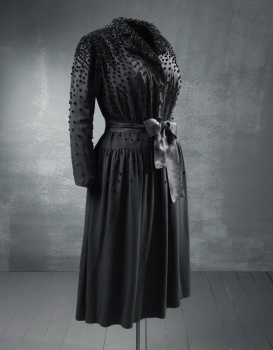

Mid-calf-length dress, with a cut below the waist. The bodice is loose, with a turndown collar and lapels. Fastens at the front with self-fabric buttons. The skirt, gathered at the waist, is made of four panels. The entire bodice is adorned with smooth velvet polka-dot appliqués, more concentrated at the neck, lapels and shoulders. The dress hugs the waist with a black silk taffeta belt.
Made in Spain, it coincides with the models used at the time, in which the shoulders were very prominent, in accordance with the military ambience of those years. The decoration evokes traditional Spanish clothing related to the world of the majos. Just like the jackets of the majos, the decoration is concentrated on the neck, lapels and shoulders. The velvet polka dots recall tassels on a macramé mesh that covered the bodies of the majas.
Details
Title: Mid-calf-length dress, with a cut below the waist
Creator: Cristóbal Balenciaga
Creator Birth Date: 1985
Creator Death Date: 1972
Fashion House: Balenciaga
Date Created: 1945
Location Created: San Sebastián, Spain
Type: Dress
Photographer: Manuel Outumuro
Rights: Cristóbal Balenciaga Museoa
Medium: Velvet, black silk taffeta
